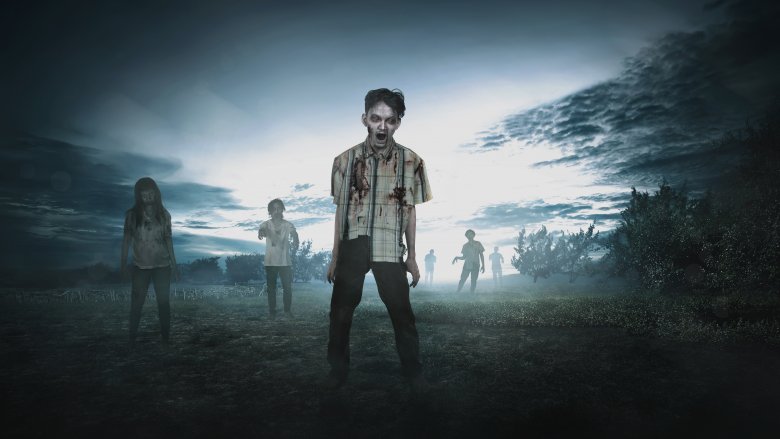Insane True Stories Of People Who Came Back To Life
If you've ever had nightmares about being buried alive, or waking up in the morgue, or being trapped inside your own motionless body, then definitely don't keep reading. These things not only happen to very unfortunate movie characters, they can — and do — occur in real life. Stories of people "coming back to life" aren't very common, but the fact that they happen at all is still pretty terrifying.
It may comfort you to know that so far, there haven't been any verifiable instances of actual zombie reanimation — at least not in the Walking Dead sense. Until that happens, these real-life stories of people who returned from the dead are more than disturbing enough.
The not-so-stillborn twin
When Kate Ogg gave birth to premature twins on March 25, 2010, she was told the boy had died, but she wouldn't let doctors take him away. "I wanted to meet him, and to hold him, and for him to know us," she told Today. Doctors handed the child over to Kate and her husband, who held him "skin to skin," a practice sometimes called "kangaroo care."
After a few minutes, the baby started to move. The nurses, evidently determined not to be optimistic, promised the parents that their baby was still dead and just moving reflexively, but Baby Jamie continued moving — and the Oggs continued telling themselves it was all reflex. Then he opened his eyes, and it became a little more difficult to continue the animated-but-somehow-still-dead fantasy.
By the time their deceased son was grabbing fingers and drinking small drops of milk, the Oggs knew they had to say something to their still totally not-optimistic medical team. Nurses continued to insist that they couldn't possibly bother the doctor with stories of stillborn babies come back to life, so the couple decided to ask for help understanding their son's death. That was enough to bring the doctor back to the room, where he then had to admit that his "deceased" patient was in fact alive and well. Oops?
The not-so-frozen teen
In 1981, 19-year-old Jean Hilliard was involved in a late night car accident in rural Minnesota. Her car skidded off the road and stalled, so she decided to walk to the home of a friend, Wally Nelson, who lived about two miles from the incident.
It was Minnesota in January, so you can guess what happened next. According to the New York Times, Hilliard almost made it to her destination, collapsing just 15 feet from Nelson's door—where he found her at 7 o'clock the next morning, frozen "completely solid, just like a piece of meat out of a deep freeze." Her body was so stiff that she had to be placed diagonally into the back seat of the car Nelson used to transport her to the hospital.
Nelson thought she was dead, and so did doctors. According to the Montreal Gazette, when Hilliard arrived at the hospital she was only breathing two or three times a minute and had a feeble heartbeat of just eight beats a minute.
Doctors gave her a slim to non-existent chance of survival, but they wrapped her in heating pads and slowly brought her body back up to a normal temperature. The girl made a complete recovery, which seemed miraculous at the time — but today we know that extremely cold temperatures have a preservative effect on the human body, and cases like Hilliard's are actually somewhat common.
Worst autopsy ever
Medical miracles like Jean Hilliard and Jamie Ogg make us feel good, but for every person brought back from the dead, there's another mistakenly identified as dead — much as we might like to believe that's something that only happened back when there were no machines that could be used to confirm death, and when "safety" coffins equipped with emergency bells (in case of accidental live burial) were a big business.
Today, the dead get to travel the long road from deathbed to morgue to autopsy table to mortuary to wake to funeral, which gives them lots of terrifying places to regain consciousness if they are not, in fact, actually dead. Carlos Camejo's resurrection, for example, happened in the worst possible place — with the possible exceptions of "after burial" or "during cremation." The Venezuelan was declared dead following a horrific car accident, but woke up during his own autopsy.
"I woke up because the pain was unbearable," Camejo told a local newspaper. The medical examiners had just made an incision on his face when they realized he was bleeding — something corpses definitely don't do.
Worst autopsy ever, part 2
It's crazy disturbing to imagine someone waking up during their own autopsy, but at least that never happens in America! Right? Actually, wrong! It totally does too happen in America. It isn't common, sure, but it isn't out of the question.
According to The Guardian, in 2014, 78-year-old Mississippi resident Walter Williams was declared dead at his home. His body was sent to a funeral home, where workers were about to cut open his arteries and fill them with embalming fluid when "he started to kick in the body bag." The coroner later said that Williams' pacemaker must have stopped working, and then was itself spontaneously resurrected after Williams arrived at the funeral home. Which, okay ... but why didn't it occur to anyone in the family that hey, maybe grandpa's pacemaker stopped working? Instead, the poor man had to experience waking up in a body bag—and almost had to endure being embalmed while still alive. Here's hoping Williams at least got a new pacemaker out of the deal.
Real-life Lazarus
In the movies, when someone goes into cardiac arrest, heroic doctors come along with their crash cart, shout "clear" a couple of times, and then congratulate each other as the patient gasps and springs back to life. In real life, resuscitation only works around 15 percent of the time. Doctors still try, though—after all, a 15 percent chance beats the zero percent chance the person would have if doctors just shrugged and gave up.
Sometimes, in fact, doctors spend an agonizingly long time trying to revive someone, only to give up, then learn minutes later that the corpse has decided to revive itself. There's even a name for this — it's called "the Lazarus phenomenon," and it's what brought Tony Yahle back from the dead. That, and a definitive order from his 17-year-old son.
According to ABC News, Yahle's medical team declared death after 45 minutes of resuscitation efforts. When Yahle's son Lawrence heard the news, he ran into his father's room and declared, "Dad, you're not going to die today." Minutes later, Yahle's cardiologist noticed signs of life on the heart monitor. Six days later, Yahle was well enough to go home.
The Lazarus phenomenon is described as "a delayed return of spontaneous circulation after cessation of CPR." It doesn't happen often, but it's common enough that standard practice is to wait until 10 minutes after stopping resuscitation efforts before officially confirming someone's death.
Insecticide hangover
Paul Mutora's bizarre decision to kill himself by drinking insecticide led to an even more bizarre spontaneous resurrection — in the mortuary, hours later.
According to the BBC, the 24-year-old Kenyan started to stir shortly before he was due to be embalmed (sound familiar?). Mortuary workers, clearly more inclined to believe in a zombie apocalypse than a medical miracle, screamed and ran from the building.
The hospital later theorized that the medication Mutora had been given slowed his heart, which accounted for the error that put him in a refrigerator instead of a hospital bed. The fact that Mutora wasn't actually dead even escaped the notice of his grieving family, who viewed his "body" the day after he was pronounced dead, and then went home to plan his funeral.
That afternoon, the family received notice that Mutora was alive and recovering in the hospital. Mutora later apologized to his father, saying "This was a mistake from the start." Though clearly the suicide attempt itself was only the tip of a ginormous iceberg of mistakes.
The lightning prodigy
In 1994, an orthopedic surgeon named Tony Cicoria was talking on a payphone when he was struck by lightning. He told a writer for the New Yorker that he recalled flying backward, then forward, then looking down at his own body.
Fortunately — or unfortunately, which is what Cicoria thought at the time — there was a nurse on the scene who immediately started CPR. Just as he was reveling in "the most glorious feeling I have ever had," he ended up back in his body.
"It's okay, I'm a doctor!" he told the good Samaritan. "A few minutes ago, you weren't," she replied.
After his near-death experience, Cicoria underwent a transformation. Before lightning struck, he'd never really been interested in music; a few years later, he'd taught himself to play piano and was composing his own songs. He was so talented, in fact, that his performance at a music retreat reportedly prompted some listeners to wish that they could be struck by lightning too.
There are still plenty of people who will tell you that near-death experiences are just a trick of the dying brain, but Cicoria actually seems to have brought something back with him. Sure, you might be tempted to argue that the lightning strike changed his brain in some fundamental way, and there's nothing spiritual about it. But no one likes a cynic.
Jung's phantasmagoria
Religious people and orthopedic surgeons aren't the only ones who have spiritual transformations during near-death experiences — they can happen to anyone, from atheists to pioneering analytical psychologists. Carl Jung himself, antagonist of Sigmund Freud, father of the whole "introvert" vs. "extrovert" debate, once had a near-death experience during a heart attack.
According to the Jungian Center, Jung described flying into outer space, where he looked down at the Earth and the subcontinent of India. He was floating near a temple, so he went inside, where he was stripped of "the whole phantasmagoria of earthly existence."
One might assume that a psychologist would have something to say about the brain's role in an experience like the one Jung described, but he believed wholeheartedly in the visions he had as being something external, outside of himself. They were "not a product of imagination," he wrote. "The visions and experiences were utterly real; there was nothing subjective about them; they all had a quality of absolute objectivity."
There will always be skeptics who think near-death experiences are in the heads of those who experience them, but Jung's story suggests that position is a lot harder to take after you've actually been through the other side.
Lived once, buried twice
This one is sort of a legend, but Margorie McCall's experience is remembered not only in the town where she lived, but also on her tombstone.
According to the BBC, McCall lived in northern Ireland, and sometime around 1705 she got sick and died. At least, that's what everyone thought. She was wearing a ring when she died — a valuable one, as it turns out — and her family was concerned that grave robbers might desecrate her final resting place in order to remove it. They tried to pry it off her, but her fingers were swollen and they had to abandon the effort.
After the wake, Margorie was taken to Shankill Graveyard and buried. As predicted, grave robbers dug her up and tried to remove the ring. When it wouldn't come off, one of them decided to just cut off the whole finger. That's when she woke up and gave the would-be thieves the most effective criminal rehabilitation lesson of all time.
After scaring the grave robbers straight, Margorie climbed out of her coffin, walked home, and knocked on the front door. Her husband answered and then fainted (in some versions of the story, he had a heart attack, died, and was buried in the same grave his wife had just climbed out of).
When Margorie died for real a few years later, she was taken back to the same cemetery. Her tombstone reads: "Margorie McCall — Lived once, buried twice."
Deliverance
Pregnancy is supposed to be a magical time — apart from all the vomiting, physical awkwardness, and cravings for dirt biscuits — but at any rate, no modern woman really expects that she might die during pregnancy. That's old-school pregnancy.
Despite all our self-reassurances, though, pregnancy is still dangerous — especially if you have an undiagnosed heart condition. According to CNN, Erica Nigrelli was 37 weeks along when she suddenly felt faint and collapsed. She was rushed to the hospital, but by the time she got there, she had no pulse.
Doctors knew they could still save her baby, so they performed an emergency c-section — when the mother is dead, the procedure is called a "postmortem delivery." But then a miracle happened: Shortly after the delivery, Nigrelli's heart started up again on its own.
Nigrelli was kept in a medically-induced coma and was able to meet her baby three weeks later. She was diagnosed with a heart condition called hypertrophic cardiomyopathy, which causes a thickening of the heart muscle.
Nigrelli made a complete recovery, and her baby wasn't expected to have any health problems as a result of her unusual birth. Nigrelli and her husband later joked to CNN that they could hang the whole thing over their poor kid's head whenever she got out of line. "I can't believe how you're acting! You do know I DIED for you, right?" And you thought your mom was a drama queen.
Michelle's miracle
It's every parent's worst nightmare: a toddler falls into a creek and is swept away. Someone calls 911, but it takes more than an hour for emergency crews to locate the little girl and pull her from the water. It's too late to save her.
In 1986, that's exactly what happened to Michelle Funk, a two-and-a-half-year-old girl who fell into a creek full of runoff from melting snow. According to the New York Times, by the time rescuers found her, 66 minutes had passed since she fell into the water. The little girl was cold and blue and had no heartbeat. At the hospital, doctors found that her body temperature was just 66 degrees. Three hours after the accident, she was still lifeless.
Weirdly, what ended up saving Michelle Funk was a math error — doctors believed she'd been without oxygen for 45 minutes, which was the longest at that time that anyone had been without oxygen and still regained normal cognitive function. If they believed she'd been gone longer than that, they would have given up.
Instead, doctors tried slowly raising her body temperature. When it reached 77 degrees, she gasped and opened her eyes. By the time she reached 98.6, she was once again a living, breathing girl. At the time, Michelle's case was "the longest documented submersion with an intact neurological outcome." The doctors dubbed it "a miracle."
Sole survivor
Twenty-one-year-old Zack Dunlap died in an ATV accident — but you've read enough of these by now that you know what we're going to say next. You guessed it: he didn't actually die.
According to Today, Dunlap and some friends were popping wheelies on their ATVs on the way home from a parade. Riding without a helmet, Dunlap miscalculated and had to swerve to avoid hitting a friend, at which point his ATV flipped and he hit the pavement.
Doctors tried to save him, but 36 hours after the accident, a PET scan revealed that there was no blood flow to his brain, which could mean only one thing: he was brain-dead.
His family knew that he'd wanted to be an organ donor, so his body was kept alive until the organ harvesting team could be flown in to do the job. But as the nurses were preparing Dunlap's body, one of his cousins decided to try just one more thing — he ran a pocket knife blade down the sole of Dunlap's foot. Dunlap yanked his foot away.
Unlike most of the rest of these stories, this one is unique because there really is no medical explanation for Dunlap's resurrection. He was just dead, and then he wasn't.
The boy who lived
When he was 11 years old, Martin Pistorius contracted a strange illness that robbed him of the ability to move or communicate. Doctors concluded that he was a vegetable, and they sent him home to die. But Martin didn't die, and was in fact aware of everything happening around him, including all the heartless and stupid things people were doing and saying because they thought their motionless companion wasn't paying attention.
According to Today, Pistorius spent 10 years like that, until one day a worker at his care center thought it might be a good idea to actually talk to him instead of just making him sit around watching Barney reruns all day. It didn't take long before she realized that the boy everyone thought had long since slipped into a vegetative state was alive, aware, and really lonely.
Now that people were willing to work with him, Pistorius learned how to communicate and eventually regained some movement, which allowed him to pilot his own wheelchair and even drive a car — he eventually married, too. A happy ending, but it's still a pretty dark story, and one that has terrifying implications. How many other "brain dead" people are alive and aware, but trapped inside motionless bodies like Martin Pistorius? It's almost too terrifying to comprehend.


